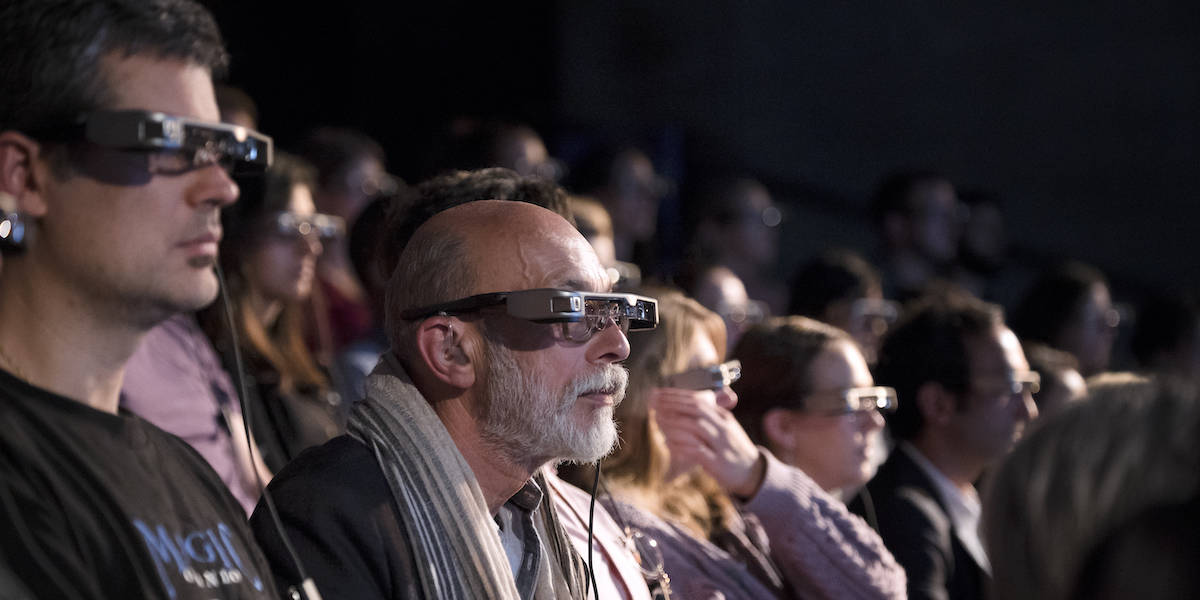Choosing suitable AR devices for the VOXReality AR Theatre has been a challenging endeavour. The selection criteria are based on the user and system requirements of the VOXReality use case, which have been extracted through a rigorous user-centric design process and iterative system architecture design. The four critical selection criteria dictate that:
- The AR device should have a comfortable and discreet glass-like form factor for improved user experience and technological acceptance in theatres.
- The AR device should support affordability, durability and long-term maintenance for feasible implementation at audience-wide scale.
- The AR device should support personalization, so that each audience member can customize the fit to their needs, and allow strict sanitization protocols, so that device distribution can adhere to high level public health standards.
- The AR device should support application development with open standards instead of proprietary SDKs for widespread adoption of the solution.
Given the above criteria, the selection process presents a clear challenge because no readily available AR solution offers a perfect fit. To address this need, the VOXReality team performed an extensive investigation of the range of available options with a view to the past, present, and future, and is presenting the results below.
The past
A quick look to the past shows that popular AR options were clearly unsuitable given the selection criteria. Specifically, affordable AR has a long, proven track as affordable and user-friendly camera-based AR, deployed on consumer smartphones and distributed through appropriate platforms as standalone applications. The restrictions on the user experience though, such as holding a phone up while seated to watch the play through a small screen, make this a clearly prohibiting option. Previous innovative designs of highly sophisticated -and costly- augmented reality devices, sometimes also referred to as holographic devices or mixed reality devices, do not support either scalability, or discreet presence required by the use case, and are also similarly rejected. Finally, a range of industry-oriented AR designs available as early as 2011 focused on monocular, non-invasive AR displays with limited resolution and display capabilities, at a prohibiting cost due to (among others) extensive durability and safety certifications. Therefore, with a view to the past, one can posit that the AR theatre use case had not taken up popularity due to pragmatic constraints.
The present
In recent years and as early as 2020, hardware developments picked up pace. Apart from evolutions of previously available designs and/or newcomers in similar design concepts, more diverse design concepts have been introduced in a persistent trend of lowering procurement costs and offering more support for open-source frameworks. Nowadays, this trend has culminated in a wide range of “smart glasses”, i.e. wearables with glass-like form factor supporting some level of audiovisual augmentation, which rely on external devices for computations (such as smartphones).
This design concept finds its origins in the previously mentioned industry-oriented AR designs, as well as their business-oriented counterparts. This time though, the AR glass concept is entering the consumer space with options that are durable for daily, street wear and tear while also remaining affordable for personal use. Some designs are provided directly bundled with proprietary software in a closed system approach (like AI-driven features or social media-oriented integrations), but the majority offers user-friendly, plug-n-play, tethered or wireless capabilities, directly supporting most personal smartphones or even laptops.
The VOXReality design
This landscape enables new, alternative system designs for AR Theatre use cases: instead of theatre-owned hardware/software solutions, one can envision system with a combinations of consumer and theatre-owned hardware/software elements. By investigating how various stakeholders respond to this potential, we can pinpoint best practices and future recommendations.
Examining implemented AR theatre use cases, one can validate that the past landscape is dominated by a design approach with theatre-owned integrated (hardware/software) solutions. Excellent examples where the theatre provides hardware and software to the audience, are the National Theatre’s smart caption glasses feature [1], developed by Accenture and the National Theatre, as well as the Greek-based SmartSubs [2] project.
One new alternative that presents itself is for audience to use their own custom hardware/software solutions dedicated to live subtitling and translations during performances. In this case, each user can choose their own AR device, pre-bundled with general-purpose translation software of their preference.
As eloquently described in a recent article though [3], general purpose AI-captioning and translations frequently make mistakes and fail to capture nuances, which especially in artistic performances can break immersion and negatively impact audience experience. Therefore, in VOXReality we design for a transition from the past to the future: developing custom software dedicated to theatrical needs, optimized at generating real-time subtitles and translations of literary text, which can also be easily deployed on theatre-owned AR devices and/or on consumer-owned devices with minimal adaptations. This is enabled by a rigorous user-centric design approach which can verify the features and requirements per deployment option, as well as contemporary technical development practices using open standards such as OpenXR.
The future
The future looks bright with community driven initiatives showing how accessible AR and AI technology can be, as in the example of open-source smart glasses you can build on your own [4], and in the continuous improvements on automatic speech recognition and neural machine translation allowing models to run performantly on ever less resources. VOXReality aims to leave a long-standing contribution to the domain of AR theatre with the objective of establishing reliable, immersive and performant technological solutions as the mainstream in making cultural heritage content accessible to all.

Spyros Polychronopoulos
Research Manager at ADAPTIT and Assistant Professor at the Department of Music Technology and Acoustics of the HMU
&

Olga Chatzifoti
Extended Reality applications developer working with Gruppo Maggioli for the design and development of the Augmented Reality use case of the VOXReality HORIZON research project. She is also a researcher in the Department of Informatics and Telecommunications of the University of Athens.
Links
[1] https://www.nationaltheatre.org.uk/your-visit/access/[2] https://smartsubs.ime.gr/results.html[3] https://www.theverge.com/2025/1/24/24351013/ray-ban-meta-smart-glasses-translation-wearables[4] https://github.com/AugmentOS-Community/OpenSourceSmartGlassesPhoto by James Bellorini, retrieved from https://www.citymatters.london/london-short-film-festival-smart-caption-glasses/

